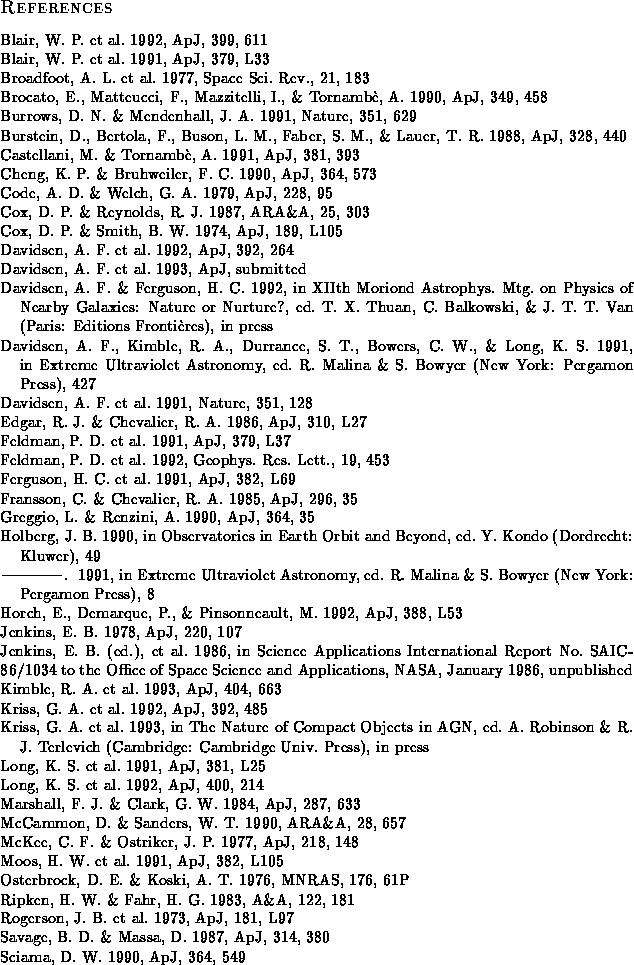 . Additionally, the hydrogen Lyman-
. Additionally, the hydrogen Lyman- clouds seen in the
spectra of quasars are expected to contain singly ionized helium, and
these clouds should also be detectable with HUT for
clouds seen in the
spectra of quasars are expected to contain singly ionized helium, and
these clouds should also be detectable with HUT for  .
.



Although detailed analysis of the data obtained by HUT on the Astro-1 mission has barely begun, it is clear that a number of significant results have already been found. Work in progress includes modeling of the spectra of several quasars and Seyfert galaxies to test theories of accretion disks around massive black holes. Several dwarf novae containing small-scale accretion disks are also being studied for new clues to the physics involved in these systems. A great variety of individual stars are being investigated, including cool stars with chromospheres and coronae and very hot Wolf-Rayet stars with strong stellar winds. Studies of the late stages of stellar evolution also include observations of UV-bright stars in globular clusters, central stars of planetary nebulae, and several white dwarfs. Further work is being done on Jupiter and the Io Torus, and there is more to be learned from analysis of the airglow spectra observed with HUT.
Before the Challenger disaster changed NASA's view of the shuttle
as a platform for astronomical observations, the Astro Observatory was
scheduled for at least three missions, and three more were under
consideration (Jenkins 1986, unpublished). Current plans call for just one more flight of the
UV telescopes, in 1994. Of high priority for the HUT science team will be a goal
that eluded us on Astro-1; namely, an attempt to detect helium in the
intergalactic medium by observing its absorption of the far-UV light of
a distant quasar. Smoothly distributed intergalactic hydrogen has not
been detected, presumably because it is highly ionized, but singly
ionized helium may be present at a detectable level. It
absorbs at 304 Å, which would be redshifted into the HUT range for redshift
 . Additionally, the hydrogen Lyman-
. Additionally, the hydrogen Lyman- clouds seen in the
spectra of quasars are expected to contain singly ionized helium, and
these clouds should also be detectable with HUT for
clouds seen in the
spectra of quasars are expected to contain singly ionized helium, and
these clouds should also be detectable with HUT for  .
.
The search for intergalactic helium has been one of the principal goals of the HUT project since its inception. It was not achieved on Astro-1 because we had insufficient time to carry out the very long observation needed to measure the spectrum of a faint, high-redshift quasar. However, this very important project may become feasible on Astro-2, especially if an extended-duration mission can be scheduled. Such a mission could achieve as many as 18 days in orbit, utilizing the new capabilities of Endeavor or the refurbished Columbia. In addition, many new scientific programs will be introduced on Astro-2 through the inclusion of a guest investigator program. Obviously, these would also benefit greatly from an extended mission. Coupled with improved operating efficiency and new optical coatings that will boost HUT's sensitivity by a factor of 2 or 3, the next mission should obtain an order of magnitude more data than achieved on Astro-1.
This project was begun at a time when multiple flights at frequent intervals were presumed possible for the Astro Observatory. It was this prospect that made the investment of years of effort by so many individuals worthwhile. Although 9 days in space has yielded a treasure trove of new discoveries, the Astro-1 mission barely scratched the surface of what can be accomplished with HUT and the other telescopes of the Astro Observatory.
I wish to record my gratitude to the individuals at NASA, in the university community, and elsewhere in private industry whose efforts were responsible for the success of Astro-1 and HUT. I am indebted to my Johns Hopkins colleagues, especially to K. Long, S. Durrance, and G. Fountain, for fundamental contributions throughout the development of this project. I also thank NASA mission manager J. Jones, former mission manager L. Allen, and mission scientist T. Gull for their contributions to Astro-1. I am grateful for the support of L. Fisk, C. Pellerin, and E. Weiler at NASA. This work has been supported by NASA contract NAS 5-27000 to the Johns Hopkins University.



